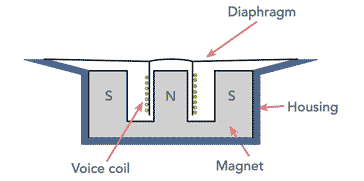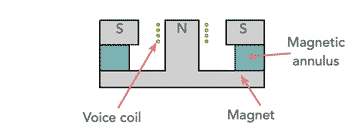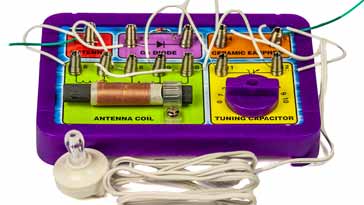How Does an Earphone / Headphone Work
Earphones & headphones are like small loudspeakers used for personal listening: many technologies used but the most common uses a moving coil in a magnetic field.
Earphones, Headphones & Headsets includes:
Introduction to earphones & headphones
How do earphones / headphones work
Wireless / Bluetooth headphones & earphones
Noise cancelling headphones & earphones
Headphone specifications
How to buy best headphones / earphones for you
Earphones and headphones provide personal listening from audio sources, and many use the same basic principles of those used by loudspeakers, but just being much smaller in size.
The technology used for earphones and headphones has obviously been developed so that they provide the optimum performance for their particular circumstances, and in this way the way in which the technology is implemented is slightly different to other transducers.
Whilst some earphones and headphones are low cost, others can be very expensive, providing exceedingly high levels of performance. Understanding how headphones and earphones work, gives real insight into knowing which types are best for different applications and why they have certain advantages or limitations.
They are used in all forms of audio reproduction from audio visual systems to audio and video editing, general studio work, serious music listening, music on the move, use with mobile phones for making calls, etc, and many many more situations.
Headphone / earphone technologies
Although most of the earphones and headphones used today use a particular technology based on magnetism, over the years other technologies such as the piezo electric effect.
Even within those earphones using magnetic effects, there have been a number of ways of implementing the technology, although, today, most using a moving coil approach.
In view of this, it is worth looking at how the different headphone technologies work to see and understand their advantages and disadvantages.
Moving coil / dynamic: The basics of this type of earphone technology are the same as those used for moving coil loudspeakers. A static magnetic field is created by a permanent magnet, and then a current is passed though a coil held within the field. The field resulting from the current in the coil interacts with that of the magnet setting up forces which cause the coil to move. The coil vibrations are linked to a diaphragm enabling the vibrations to move more air, and in turn allowing the vibrations to be heard.
Planar magnetic or orthodynamic headphones: Planar magnetic headphones use a thin diaphragm suspended between a series of magnets. The diaphragm incorporates a thin conductor that is tracked backwards and forwards in line with the magnets and the audio signal passes through this to enable the diaphragm to move in line with the incoming signal.
Balanced armature technology for in-ear monitors: the balanced armature headphone technology was initially developed for hearing aids. It is easily miniaturised and apart from hearing aids it is often used for in-ear monitors, etc where the small size of the headphone / earphone driver is important.
Piezoelectric earpiece: The piezoelectric effect is an effect whereby when an electric potential is applied across a particular material, a stress will be set up. This causes the material to distort and hence it will move. These movements are then linked to a diaphragm to give sufficient air movement for the sounds to be heard.
Materials the exhibit this effect are called piezoelectric materials and the include substances such as quartz, and a number of other ceramic based materials and crystals. Sometimes these earphones may be referred to as crystal earphones, and they tend to have a very high impedance.
How does a moving coil earphone / headphone work
A moving coil earphone or headphone is almost the same as a loudspeaker. Rather than the rather conical shape of the diaphragm for a loudspeaker, earphone diaphragms tend to be flatter to conserve space.
The diagram below shows a cross section of main elements of a typical headphone of earphone to show how it works and its basic operation.

The main element is a magnet which is used to create a steady magnetic field in which the coil is held. This can take a variety of physical forms dependent upon the size, design, etc. Sometimes the whole magnetic element may be magnetised, other times there may be a smaller magnet sandwiched in a magnetic assembly of ferromagnetic material.
Normally the main magnet is a ring magnet, often made of a rare earth material called Neodymium as this can give a strong magnet, and hence a strong magnetic field. This normally has the South Pole facing upwards and the North Pole downwards.
To this a ring shaped pole piece is attached to the top of the magnet and a plate to the bottom, but with a central cylindrical vertical section around which the coil will be located, although without touching so it can move freely.

The shape of the overall magnet structure is important because it maximises the magnetic field strength across the voice coil and this improves the efficiency and overall performance. The shape also enables the coil to move freely without being hindered by any physical restraints apart from the diaphragm which holds it in place.
There is coil normally called a voice carries the current created by the audio source. This is actually the audio signal that needs to be converted from an electrical signal into a series of audio vibrations. As might be expected, the electrical signal flowing in the voice coil varies in line with the audio vibrations required.
As mentioned, the coil is suspended in a suitable cylindrical cutaway within the magnetic structure so that the coil does not touch the sides, etc under any normal operating circumstances.
The current within the voice coil sets up its own magnetic field. This interacts with the magnetic field from the fixed magnet. As like poles attract and unlike ones attract, forces are set up, and this causes the coil to move in and out of the magnetic field slightly in line with the level of current flowing on the coil. The principle used is essentially electromagnetic induction - the same principle as used in electric motors, electric relays, bells and the like.
The movements of the voice coil are transferred to the diaphragm which is used to move a larger volume of air which makes the vibrations audible.
In view of the size of the earphone or headphone, the suspension materials used in a typical loudspeaker are not required - the diaphragm is sufficiently strong to hold the coil within the required tolerances relative to the magnet so that it does not touch.
The voice coil is normally small and the wire relatively thin as the levels of current needed for headphones and earphones are much smaller than those needed for loudspeakers. The connections to the voice coil are normally thin wires that are linked to the back of the earphone so that the electrical signal can be easily entered into the earphone assembling. Te way in which the connections to the voice coil are arranged is crucial to the operation of the headphone. If they impede the movement, then they will impact the performance significantly.
As many people like extended bass response to improve the presence of the signal, this type of headphone technology enables the bass response to be enhanced within the design.
Many high quality headphones tend to have an enhanced bass response, although those used for studio work will often aim for as flat a response as possible to ensure that the sounds are heard as accurately as possible.
Planar magnetic or orthodynamic headphones
This type of headphone is considerably less widely used than the moving coil type, but it has been used to provide earphones / headphones with some advantages.
Orthodynamic headphones may also be referred to as isodynamic, planar-magnetic, or magnetostatic because they utilise the characteristics of both dynamic or moving coil and electrostatic headphone driver design.
Looking at how these headphone drivers work, it is necessary to first look at their construction. A series of thin bar magnets are set up as either side of the diaphragm. Space is required between them so that the sound can travel outwards without being unduly impeded.
In fact the magnets are arranged such that the magnets on one side of the diaphragm align with spaces on the other. Also the poles of the magnets change on the same plane as the diaphragm and are opposite on opposite sides.
The conductive element for the planar earphone technology form part of the diaphragm itself. The conductive element is thin and flat, and formed into the diaphragm - it needs to be very light weight so that it does not unduly impact the performance of the diaphragm. It is ultimately connected tot he two terminals of the earpiece / headphone so that the drive power can be supplied to it. Normally the wires come out to the edge of the diaphragm where they can easily be routed to the connection terminals without the need for separate flexible connections to the equivalent of the voice coil.
In operation, the magnets arranged either side of the diaphragm provide a concentrated magnetic field in this region. When a current flows through the diaphragm conductor it reacts with the steady field produced by the magnets, attracting and repelling the conductor and hence the diaphragm. Note that the fixed magnetic field is arranged either side so that the field from one side will pull attract the conductor / diaphragm, and the other side will repel it. This enables a effective and efficient movement of the diaphragm so that good air movement and hence sound is produced.
Planar earphones have the advantage that since the diaphragm reacts across the whole surface at once, it does not need to be as rigid as those used for dynamic and other types of earphone/. This cuts down significantly on the weight and hence the inertia. This enables the earphone to respond very quickly and very accurately to the electrical impulses provided and hence it can reproduce the sound very accurately, thereby giving a very impressive sound.
Headphones using this technology tend to have a much flatter response than dynamic ones which often have enhanced bass response for added "presence." This sometimes can mean that they lack the impressive sound that many higher end dynamic ones have, but overall the response can be far more true to the real sound.
Balanced Armature Headphone
Another earphone technology that is used in some instances is known as the balanced armature earphone or driver.
The technology was invented in 1955 by Hugh Knowles to provide a very small earpiece for hearing aids. The company he founded, Knowles Electronics is still in business supplying hearing aids.
In view of the small size of balanced armature drivers, they are used chiefly for in-ear monitors and other applications where miniature drivers are needed. In fact hearing aids almost exclusively used balanced armature drives because they can be miniaturised to fit well into the ear. Also they require less audio drive and this helps preserve batteries - a key factor in hearing aids.
To understand how balanced armature earphones work it is necessary to look at their construction.
The basic driver consists of a coil that is wound around an armature that is balanced between a magnetic assembly that has opposite poles either side of the armature. The coil does not move and this means that it is possible to use more turns than on a dynamic earpiece, and this enables the coil to create a much greater magnetic field, and there is also greater latitude in the impedance during the design. Different impedance levels will be needed for different types of driver.
To enable the vibrations of the armature to move greater volumes of air so that the vibrations become audible, the armature is linked to a diaphragm via what is termed a drive pin.
Balanced armature earphone drivers are full enclosed except for a small opening called the sound outlet. This allows the sound produced by the armature and hence the diaphragm to propagate out of the enclosure to become audible outside.
The case is an important element of the balanced armature earphone driver because the actual mechanism is relatively delicate and needs to be enclosed to properly protect it.
In terms of its operation, a signal is applied to the external connection wires which connect through the enclosure to the voice coil. When the signal varies, it causes the induced magnetic field to vary. As the armature is made of magnetic material, the field induced by the voice coil "travels" along the armature, and interacts with the field from the fixed magnets causing the armature to be attracted and repelled by them. The fixed magnets produce opposing magnetic fields.
In view of the fact that the balanced armature earpiece can be miniaturised so well, it provides the possibility of having two drivers in a single earpiece like having a woofer and tweeter in a loudspeaker. This enables the frequency range to be extended to to improve the performance. However the enhanced bass response provided by many dynamic earphones is not normally achieved using balanced armature drivers. When used for headphone applications, they can lack the "presence" that can be created using dynamic drivers.
Piezoelectric or crystal earpieces
Although not aimed at the high quality market, occasionally crystal or piezoelectric earpieces are seen. Often they are aimed at the hobbyist market now for items like crystal radio sets where their high impedance is useful.
The basic concept of the crystal earpiece is that it uses a piezoelectric element. When a potential is applied across a piezoelectric crystal a stress is set up across it and it deforms or bends slightly. With a sound waveform, vibrations are set up on the crystal conforming to the electrical signal for the sound. If this is linked to a diaphragm in some way, then a larger amount of air can be moved and the vibrations heard.
There are many different ways in which a crystal earpiece can be made, but one format is shown in the diagram below.

One of the key attributes of crystal earpieces was that they offered a very high impedance. The DC resistance was almost infinite because of the use of the piezoelectric transducer. This made them ideal for use with many circuits where a very high impedance was needed - crystal radio sets being one example (by the way they gain their name from the crystal rectifier used, and not the crystal or piezoelectric earpiece).

However crystal earpieces were not known for their quality of reproduction and are not generally used in this form in mainstream audio applications. It is also interesting to note that these crystal earpieces are normally only found singly and not as stereo sets.
There are several forms of headphone technology that are used and have been used for earphones and headphones. Today's headphones and earphones have optimised the technologies used to give very high levels of performance and in terms of frequency response, distortion, etc typically have much better specifications than loudspeakers, but they obviously cannot provide the same experience and speakers in view of the fact that they are earphones.
Today's headphones, earphones, earbuds, headsets and the like are used in many ways and for many different forms of audio or audio visual applications and as a result different formats, and different technologies are needed. Accordingly there are many different types of headphone available to suit the needs of virtually all situations and needs. Understanding how the different headphone and earphone technologies work helps with the selection of the right item and also to understanding its advantages and limitations so the best use can be made of and particular headphone or earphone set.
 Written by Ian Poole .
Written by Ian Poole .
Experienced electronics engineer and author.
More Audio Video Topics:
HDMI
SCART
DisplayPort
DVI
Loudspeaker technology
Headphones & earphones
Bluetooth speakers
Stereo sound
Microphones
Audio compact cassettes
Vinyl record technology
Digital radio
DVB television
Return to Audio / Video menu . . .


